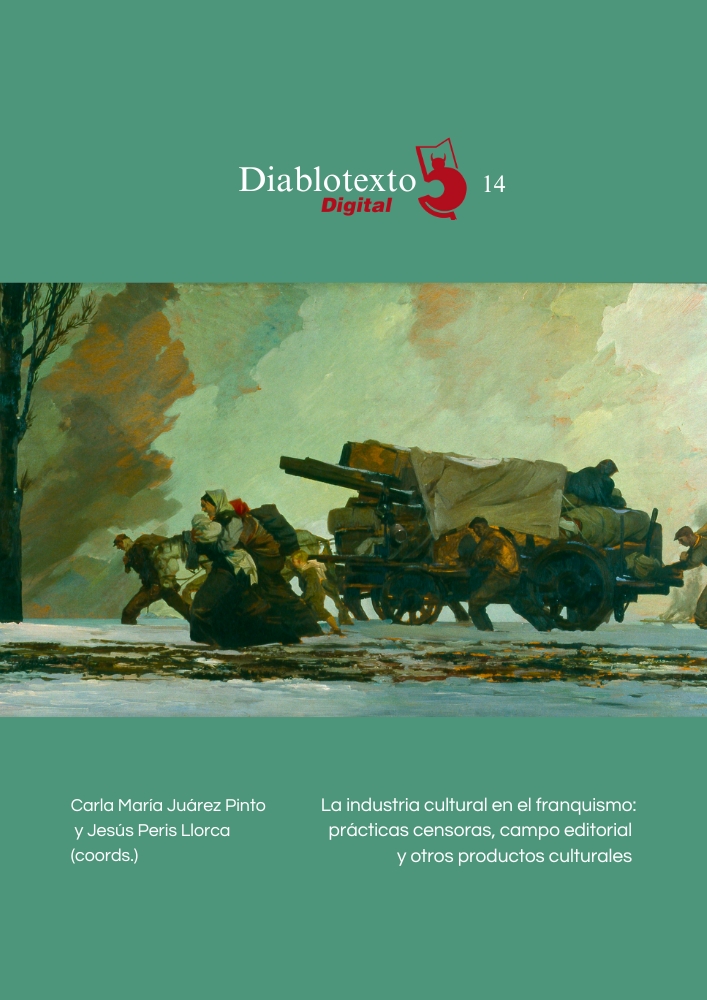Approach to the Study of Theatre Networks in Bizkaia (1939-1975): Notes on Spaces, Modes of Dissemination, Groups and Playwrights
DOI:
https://doi.org/10.7203/diablotexto.14.27631Keywords:
theatre, Bizkaia, Francoism, dissemination, creation Abstract
Abstract
This article aims to shed light on the models of theatrical creation and dissemination in Bizkaia between 1939 and 1975. To do so, we have catalogued the different actors in the theatrical historiography: the companies, the authors and the theatres. We have paid attention to questions relating to the cultural policy of the time, in particular to the work carried out by publishers and radio stations when it came to disseminating dramatic works.
 Downloads
Downloads
 References
References
Aguirre Sorondo, Juan (2005). “Elías Amézaga, generosidad más allá de la palabra”, Revista internacional de estudios vascos, n.° 50, vol. 2, pp. 595-603.
Amestoy, Ignacio (2020). “Cuando fui amigo de Txabi Etxebarrieta: ¿ha sido la serie La línea invisible justa con él?”, El Español, 12-05-2020.
Aresti, Gabriel (1966). “Kriselu, un grupo de teatro vasco”, Hierro, 04 de junio.
Arozena, Eugenio (2006). Zentsuraren gurpilean euskarazko antzerkia 1940-1980. Zarautz: Oiartzungo udala.
Arozena, Eugenio (1991). Augustin Zubikarai eta euskal antzerkia. Donostia: Antzerti argitarapenak.
Ascunce, José Ángel, Gereñu, Idoia y Gil Fombellida, Mari Karmen (2012). 1936ko euskal erbestealdiko antzerkia. El teatro del exilio vasco de 1936. Donostia: Hamaika Bide.
Bacigalupe, Carlos (1988). Bilbao a escena, Bilbao: Desclée De Brouwer.
Bacigalupe, Carlos (1997). “Apuntes para una historia del teatro bilbaíno. Elías Amézaga, el autor teatral vasco más prolífico”, Bilbao, febrero, n.° 102, p. 32.
Barea, Pedro (2005). “Radio bilbaína, voluntarios y creativos, emprendedores y comerciantes, propagandistas e informadores: un medio de comunicación que construyó ciudad”, Bidebarrieta, n.° 16, pp. 267-285.
Barea, Pedro (2001). “Creación literaria en la radio bilbaína”, Bidebarrieta, n.°9, pp. 149-182.
Barea, Pedro (1977). “2 espectáculos, un libro y algunas noticias más”, Pipirijaina, n.° 4, junio, p. 17.
Bilbao, Mikel (2012). “Arquitectura teatral en Bilbao durante los siglos XIX y XX. De los lugares para la memoria a los espacios recuperados”, Bidebarrieta, Revista de humanidades y ciencias sociales de Bilbao, n.º 23, pp. 37-52.
Del Olmo, Karlos (2017). Arestiren nazioa, antzerkia. Azpeitia: Ehaze.
Gereño, Xabier, (1964). “Euskal antzerki taldeai deya”, Zeruko Argia, 16-02-1964, p. 4.
Gereñu Odriozola, Idoia (2016). Jarrai (1959-1968), abangoardiako euskal teatroaren ikur / Jarrai (1959-1968), hito del teatro vasco de vanguardia, tesis de doctorado. Disponible en https://e-archivo.uc3m.es/handle/10016/23081#preview [Fecha de consulta: 20 de diciembre de 2023].
Gereñu Odriozola, Idoia (2018). “Teatroaren mututzea XX. mendean. Frankismoaren eta zentsuraren eragina euskal teatroaren bilakaeran”, Euskera, n.° 63, pp. 731-763.
Gil Fombellida, Mari Karmen (2008). “Antzerkia eta nortasuna: Gerra Zibilaren aurreko euskal erbesteko fenomeno dramatikoari buruzko lehen oharrak”. En José Ángel Ascunce Arrieta (coord.), El exilio: debate para la historia y la cultura. Donostia: Saturraran, pp. 333-344.
Gil Fombellida, Mari Karmen (2009). “Antzerkia eta nortasuna. Gerra zibilaren aurreko euskal erbesteko fenomeno dramatikoa”. En Iñaki Beti Sáez y Carmen Gil Fombellida (eds.), Exilio y Artes Escénicas, Arte eszenikoak erbestean. Donostia: Hamaikabide elkartea, pp. 417- 423.
Goenaga, Aizpea (2021). “Breve historia del teatro vasco”. En Pedro Barea y Aizpea Goenaga, Antzerkia/Teatro. Etxepare Euskal Institutoa, pp. 14-71.
Izaola Azkorra, Joseba (2023). “Txinpartak Euzkal Antzerki Taldea”. Auñamendi Entziklopedia. Disponible en https://aunamendi.eusko-ikaskuntza.eus/eu/txinpartak-euzkal-antzerki-taldea/ar-157128/ [Fecha de consulta: 22 de diciembre de 2023].
Lete, Xabier (1965). “Aresti´ren Beste mundukoak 'ekin teatro berria asi zela, esan genezakegu”, Zeruko Argia, 24-01-1965.
Merino, José Luis (1998). “Un joven de 22 años”, El País, 05-05-1998.
Monleón, José (1967). “Arrabal en Bilbao”, Triunfo, n.° 260, 27-05-1967, p. 13.
Palomino Arjona, Manuel (2019). Dramaturgia asturiana contemporánea. Lulu.
Ruiz cano, Marina (2021a). “La escena teatral en Bilbao desde 1960: entre capitalidad bífida y acefalismo”, Iberic@l - Revue d’études ibériques et ibéro-américaines, n.° 20, otoño de 2021, pp. 65-76.
Ruiz cano, Marina (2021b). Espaces, mémoires et identités dans le théâtre espagnol : le cas du théâtre au Pays basque (1979-2004), tesis de doctoral inédita.
Sudupe, Pako (2009). Tradizioa eta modernitatea 50eko hamarkadan. Hernani: EHU.
Torrealdai, Joan Mari (2006). “Uztarriako elkarrizketak: Juan Mari Torrealdai”, Uztarria, 13-02-2006.
Torrealdai, Joan Mari (2000). Artaziak. Euskal liburuak eta Francoren zentsura 1936-1983. Zarautz: Susa.
Torrealdai, Joan Mari (1999). “Zentsurak basamortu kulturala ekarri zuen”, Euskonews & Media, p. 37.
Torrealdai, Joan Mari (1997). Euskal kultura gaur. Donostia: Jakin.
Urkizu, Patri (2009a). “Euskal antzertia erbestean [1937-1959]”. En Iñaki Beti Sáez y Carmen Gil Fombellida (eds.), Exilio y Artes Escénicas, Arte eszenikoak erbestean. Donostia: Hamaikabide elkartea, pp. 349-367.
Urkizu, Patri (2009b). Teatro vasco. Historia, reseñas y entrevistas, antología bilingüe, catálogo e ilustraciones. Madrid: Cuadernos Uned.
Urkizu, Patri (2000). “Nemesio Etxanizen 100. Urteurrena dela eta”, Oihenart: Cuadernos de lengua y literatura, n.° 18, pp. 127-132.
Zelaieta, Angel (2000). Gabriel Aresti (biografia). Zarautz: Susa.
Fondo Elías Amézaga de la Biblioteca de Bidebarrieta (Bilbao).
Inventario del Fondo A189 – Aitor De Goiricelaya. Disponible en https://www.eresbil.eus/sites/fondos/wp-content/uploads/sites/11/2017/07/A189-Inventario-1.pdf [Fecha de consulta: 20 de diciembre de 2023].
Catálogo “Sudoc - Système Universitaire de Documentation”. Disponible en https://www.sudoc.abes.fr/ [Fecha de consulta: 20 de diciembre de 2023].
Downloads
Published
How to Cite
-
Abstract205
-
PDF (Español)65
Issue
Section
License
Licencia de reconocimiento de Creative Commons “Reconocimiento - No Comercia l- Sin Obra Derivada
Authors who publish with this journal agree to the following items:
The authors will keep their copyright and guarantee the journal the right of first publication of their work, which will be simultaneously subject to the Creative Commons license that allows third parties to share the work indicating its author and its first publication in the journal. The authors may adopt other non-exclusive license agreements to distribute the version of the published work (e.g., depositing it in an institutional telematic file or publishing it in a monographic volume), with an acknowledgment of its initial publication in this journal. The authors are allowed and encouraged to disseminate their work through the Internet (e.g., in institutional telematic archives or on their website) before and during the submission process, which can produce interesting exchanges and increase citations of the published work. (See Effect of Open Access)




